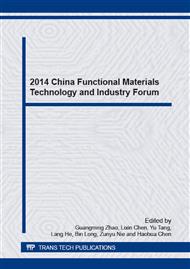p.3
p.9
p.17
p.26
p.31
p.39
p.43
p.53
p.59
Lubrication Mechanism of Nanoparticles in Metal Hot Deformation
Abstract:
Effect of nanoparticles to improve the lubrication load capacity and resistance to extreme pressure of water-based rolling liquid was studied by four-ball tester. Compression experiments were conducted in different lubrication conditions with nanoparticles using Gleeble hot compression simulation machine. Then the residual nanoparticles characteristics and the surface morphology of the compressed sample were analyzed by SEM and EDS. The results show that water-based nanoTiO2 lubricant can efficiently reduce the friction during metal deformation. nanoZnO is preferred to adhere to metal surfaces and employed to isolate the surfaces. A new lubricating mechanism of nanoparticles in metal hot deformation named convex peak extreme pressure buffering mechanism is thereby proposed, which is verified by the surface morphology of compressed sample.
Info:
Periodical:
Pages:
31-38
Citation:
Online since:
December 2014
Authors:
Price:
Сopyright:
© 2015 Trans Tech Publications Ltd. All Rights Reserved
Share:
Citation:


